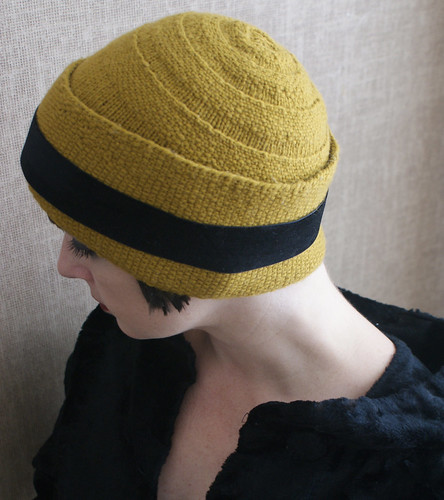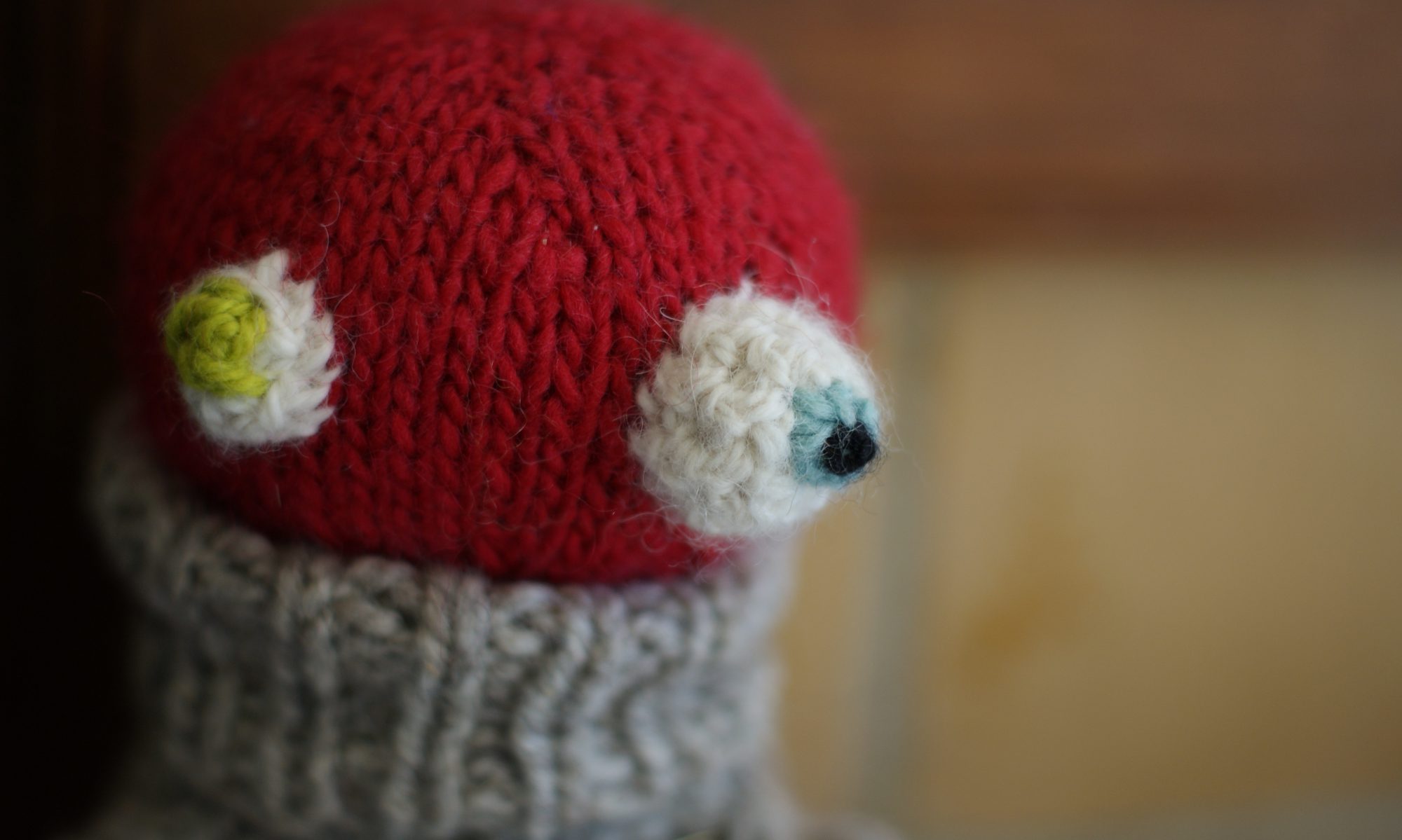Well, for me, tomorrow (spiritually tomorrow, as I’ve not yet gone to bed, but technically today). It’s 3am & I’m just getting to this. My productivity actually got the better of me (yay!) and kept me busy for much of today, although Sunday is supposed to be Fun Day, dedicated to goofing off. But when Ron and Twyla both took a much-needed, lengthy nap, I got on a TCB bender which carried on most of the night, interrupted only by a trip to Sonic for a junk food dinner without guilt or dishes (Sunday is Fun Day!).
I plied that TdF single (lovely, but wet; I’ll shoot it tomorrow) and cleaned and organized my room (which is a sort of studio apartment minus the kitchen setup, so I covered my bedroomy space, plus Twyla’s space & the bathroom/changer zone). I didn’t finish every last bitty bitty bit, but it looks pretty spiffy, at least compared to its natural state of chaos.
So, Daisy! Here’s the Daisy Cloche from the book, worked in Quince & Co. Lark in Honey.

When I knit Daisy last month, I stuck with Lark in the only colorway with 2 skeins in my stash: Peapod, a perfectly snappy color, but one that doesn’t suit me well, so I’ll likely dye it. For the knitalong, I’m going to experiment with 220 from stash and see how it goes. If it’s a fail early on, I’ll switch to something else, but that’s my Plan A. 220 isn’t as bouncy as Lark, but I’m hoping it will cooperate.
Helpful links:
Daisy Cloche on Ravelry
Literary Knits Errata
Literary Knits Group on Ravelry
Daisy KAL Question Thread (Please post questions here so I can answer for everyone–I’ll be checking and answering at least daily)
Daisy KAL Progress Thread


Heads up, before we get underway… ERRATA!
So, working straight from the book, here’s what I discovered, to my great dismay: there is a short but critical line missing between the “Short-Row Section on Hat Body” and “Concentric Circles.”
Knit back to marker, then work 2″ in St st, k2tog on last 2 sts of final rnd.
I can’t apologize enough to the folks who knit the pattern from the book and produced an abbreviated version of the design. (It’s unconscionable, and never would have gone uncorrected for so long if the publication of the book hadn’t coincided with the birth of my daughter. That’s not me blaming Twyla, but me blaming me for being ill-equipped to deal with anything beyond business-as-usual+baby for a very, very long time. I wasn’t knocked up when I started the book or when the publication date was set, but I couldn’t have anticipated how the shape of my day/year/life would change.)
Okay, so that, which you probably won’t hit today unless you’re out of your mind, because there’s a sea of linen stitch, plus a bunch of short rows, between casting on and the missing lines. But flag it now. And the other errata is that all of the PU numbers on the Concentric circles are off by one:
2nd Circle: …pick up and knit 86 more sts (87 total)….
3rd Circle: …pick up and knit 64 more sts (65 total)…
4th Circle: …pick up and knit 42 more sts (43 total)…
and at the center: …pick up and knit 20 more sts (21 total).
When you k2tog across the rnd after that last section, your final st will be a K st, bringing you back to 11 sts.
Both of these are on the Literary Knits Errata page, and also linked in the ravelry pattern page.
And some general thoughts on the pattern overall…
- Do swatch, and check your gauge again after about an inch of linen stitch. I tend to knit loosely, but linen stitch tenses me up and if I don’t watch it, my gauge gets tighter and tighter. I actually frogged the whole brim this last time because I got so uptight that my gauge seized up.
- For the record, I loathe knitting linen stitch, but I really love the way it looks, so I suffer through it. While it’s one of my favorite stitches to wear–so simple yet decidedly un-knitty, so elegant–actually knitting it could be politely described as double lame-o donkey dick. Sorry.
- Strive to cast on nice, even stitches. The linen stitch that follows them is tighter than they are, so if they’re loosely goosey, the’ll show up more than usual on the edges.
- When you cast off in pattern for the circles, it’s a bit strange because you can really only control every other stitch (the ones you’re knitting, while the ones you slip are already set).
- You definitely want to block this hat. A hot bath and a dry on a form makes the difference between a crisp, tailored product and a stretchy cap with a very different look and fit. (I like those Styrofoam heads–you can get one for around $5 or so on Amazon or eBay. It’s a good investment for hats in general, especially if you knit a lot of cables or lace–a block on a form really helps your stitches pop. In a pinch, you might be able to fashion something suitable from the right pillow, ball, bowl, or even a plastic bag stuffed with socks or packing peanuts).
- If you get lost within the linen stitch on the short rows (or anywhere else), just look to the row below you. If the stitch on the previous row was slipped, it will be worked; if it was worked, it will be slipped. When you’re on the RS, you always slip with yarn in front; if you’re on the WS, slip with yarn in back. If you’re on the RS, working means knitting; on the WS, working is purling.
- Turn off the TV for the linen stitch short rows. The dense stitch makes it hard to find your place if you get distracted.
And some specific advice on what you’ll probably be working on for the next couple of days…
(This is my attempt at clarifying the general construction of the hat and its use of short rows.)
You’ll work the short rows of the brim centered over the back of the hat, so that you’ll flare up the brim in the back. When you get to the main body of the hat, you’ll work short rows centered over the front of the hat instead. The two combine to offset the concentric circles more dramatically.
So, for the brim you’ll be working back and forth past your center marker, turning on either side of it. Starting with the RS, you’ll work X sts, then turn to the WS, work X sts back to the marker, continue past the marker X sts, then turn your work back to the RS and work back to the marker and then another full round. X=44 for the first set, then 49, then 54.
Please do fire away on the Questions thread if you have any questions! I started this KAL because it’s one of the trickier patterns in the books, so I want to help as much as possible!
